You say it is too hot out to turn your oven to 500 degrees and roast a chicken for an hour…I say “Chicken under a brick!” You say you want moist breast meat and crispy skin…I say “Chicken under a brick!” You say you want a lot of flavor without a lot of hassle…”Chicken under a brick!”
Chicken under a brick is a great way to cook a whole chicken on the stove instead of in the oven. In order to get all this goodness you need to butterfly the chicken or “spatchcock” it. Yep, give it a good spatchcocking…which is to half the chicken by removing its backbone. Doing this allows you to flatten the chicken, making it all the same thickness. When you do this, the breast meat and the thigh meat can cook at the same pace. A lot of the fat in the chicken also renders out. The chicken will cook in this fat and yummy juices, instead of the dry air of the oven. All that rendered yumminess also crisps up the skin… bonus.
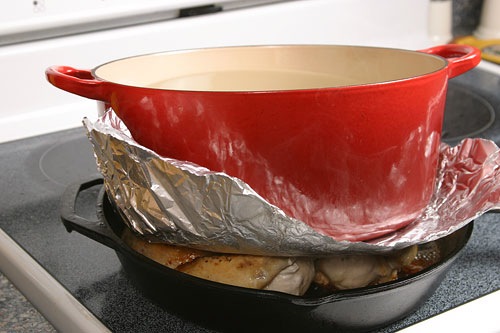
I got us a rather large bird, roughly 4.3 lbs. I would go for a smaller bird next time, maybe something closer to 3 lbs as the recipe calls for. Of course I got the bird first and then found the recipe. That’s just how I roll. A smaller bird would be more tender and the meat would be less thick.
I had to cook the chicken a little longer since it was bigger. Unfortunately, the breast meat got just a wee bit over cooked. The recipe I used said to check the doneness in the thigh meat, but I saw a similar recipe that said to check the breast meat for doneness instead. The recipe also recommends cooking until the thigh meat registers 175 degrees which is way too long.
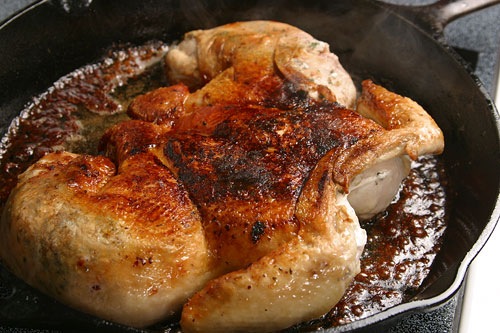
I also found a recipe (and in turn a great blog…seriously give it a read) that calls for cooking the chicken skin side on the stove and then finishing the chicken in the oven. Seems like it could definitely work. Last piece of advice, season the chicken under the skin or else all the seasoning will just scorch.
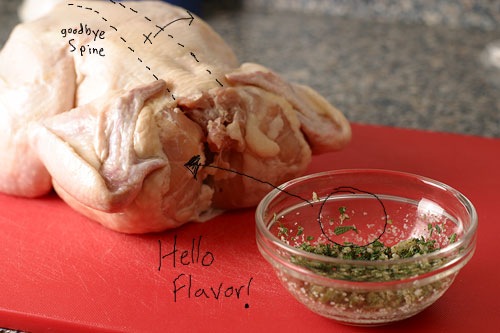
Chicken Under a Brick
Based on a recipe from: Cook’s Illustrated
- 2 teaspoons minced fresh sage leaves
- 1 medium clove garlic, minced
- Table salt and ground black pepper
- 1 whole chicken (3 pounds), butterflied
- 1 tablespoon vegetable oil
Directions:
Butterfly the chicken
- With the breast side down and the tail of the chicken facing you, use kitchen shears to cut along one side of the back bone down its entire length.
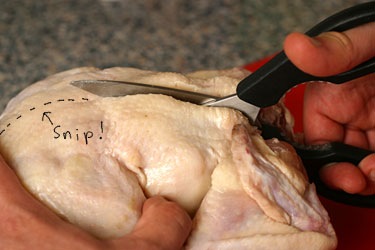
- With the breast side still down, turn the neck end to face you and cut along the other side of the backbone and remove it.
- Turn the chicken breast side up; open the chicken out on the work surface. Use the palm of your hand to flatten it.
- (Optional, this makes for better presentation, but I think it makes it harder to get the chicken all the same thickness -L) Make half-inch slits on either side of each breast about one inch from the tip; stick the legs into these openings.
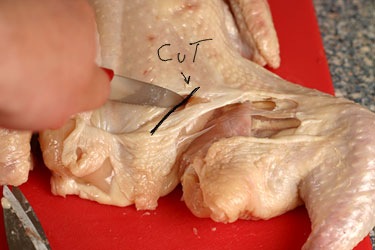
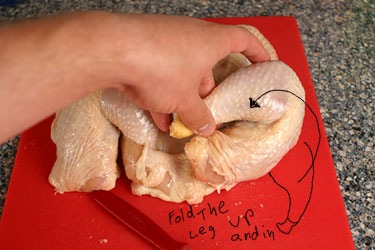
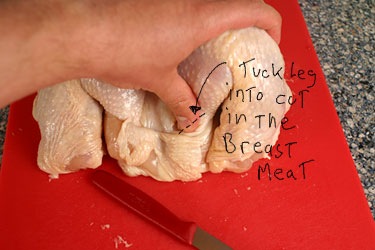
- (Optional, I skipped this step but it would be helpful if the thickness were very uneven -L) Use the smooth face of a mallet to pound the chicken to approximately even thickness.
Cooking the chicken
- Mix the sage, garlic, 1/2 teaspoon salt and 1/4 teaspoon pepper in a small bowl.
- Loosen the skin on each leg and thigh. I used the handle of a wooden spoon, or you can just use your hand. Rub the herb mixture under the skin. Then loosen the skin covering the breast and rub the remaining herb mixture under the skin. Lightly season chicken with salt and pepper. Let stand at room temperature 15 minutes to allow flavors to meld.
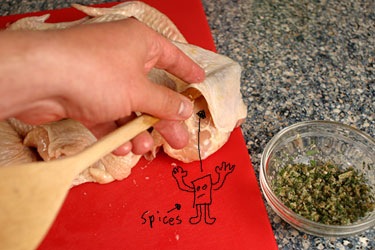
- Heat the oil in a large sauté pan. Cover bottom of a Dutch oven or stock pot that has a diameter slightly smaller than the sauté pan you intend to use, with foil and fill with 5 quarts water. You could also use bricks covered with foil. I used my cast iron pan for cooking the chicken, it was made for stuff like this.
- Once the oil is shimmering, lay the chicken skin side down in sauté pan. Set the Dutch oven (or other weight) on top to hold the chicken flat.
- Cook over a medium-high heat until skin is nicely browned, about 10 to 15 minutes.
- Remove Dutch oven; turn chicken skin side up. Replace Dutch oven and continue cooking until instant-read thermometer inserted into thickest part of the breast reads 165, about 15-20 more minutes. (The original recipe calls for cooking until the thigh registers 170 to 175 degrees, but that is too long and the meat will dry out. Most other chicken recipes I found call for cooking the meat to 160-165 degrees. -L)
- Transfer the chicken to a plate to rest and tent with foil. I just reused the foil I had from covering the Dutch oven.
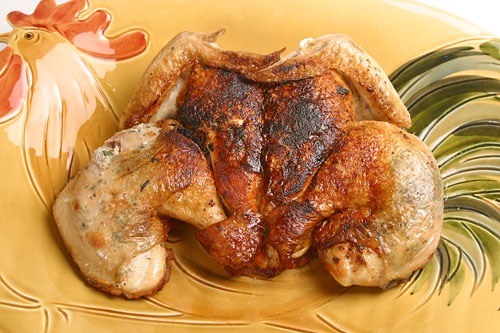
This was the most juicy chicken I’ve ever made! I made oven roasted red potatoes with olive oil, rosemary, and salt and pepper for a side.
Added wine and chicken broth to the drippings for a great sauce.
This is a delicious recipe that I first learned about on TV’s America Test Kitchen. I really enjoy the pictures / diagrams on this website.
My family loves it!
I was just at the library today and looking at the most recent issue of Cooks Illustrated, they have a writeup on Grilled (gas and charcoal) Chicken under a Brick. Definitely want to try. Tried a version on the stove-top and it turned out well, although I disagree with the idea that you shouldn’t use teflon as the recipe I followed suggested. I left a lot of skin on the pan. :( I also used foil-wrapped bricks!
Pingback: Za'atar Chicken Under a Brick | The Fresh Dish
haha, not only did i love the illustrations and your writing style, i also love the new blog you advised us to head too! we’re making this chook as part of our monthly cooking comp, can’t wait to see how if it tastes as good as it looks!
Rosemary is another great spice to use on this dish.
The diagrams really are helpful. Cute too.
Pingback: Columbus Foodie » Blog Archive » May 2008 Roundup
I loved your little “goodbye spine” diagrams etc… They made me giggle :)
Pingback: Meals: Bricked-Chicken & Pesto Sandwich